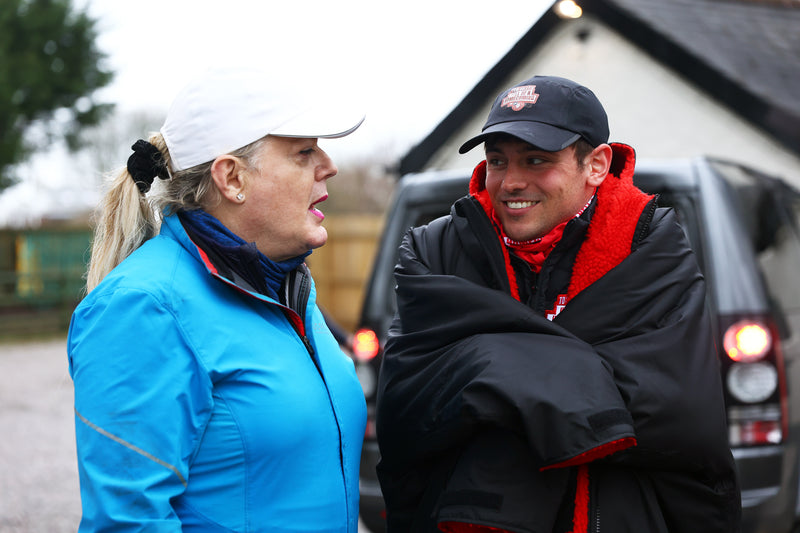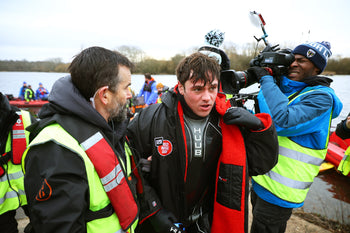10 Minuten Lesezeit
Earlier this year diving superstar Tom Daley took on the challenge of his life for Red Nose Day - rowing, cycling, swimming and running his way from the Queen Elizabeth Olympic Park in London to his hometown of Plymouth for one hell of a homecoming! We caught up with his coach, dryrobe® Ambassador Keri-anne Payne, to find out how he trained for the brutal cold water swim section of the challenge.

An Olympic gold medalist, Tom is Team GB’s most decorated diver of all time, with 11 World, Commonwealth and European Championship gold medals and four Olympic medals to his name. This year Tom was awarded an OBE for his work as a human rights activist and an LGBTQ+ campaigner.
‘Tom Daley’s Hell of a Homecoming’ saw him row 6 miles and cycle 60 miles from London to Reading on Day 1, swim 1600 metres and cycle 63 miles finishing in Southampton on Day 2, Cycle 130 miles to Dartmoor on Day 3, before taking on a 30-mile ultramarathon finishing in Plymouth on Day 4! We were proud to supply Tom with a custom dryrobe® Advance to keep him warm and dry throughout the challenge.
As part of his training for the swim section of this epic homecoming, he was coached by Keri-anne Payne. A two-time 10-kilometre open water world champion and an Olympic silver medallist, her incredible performances helped inspire a generation of outdoor swimmers. Since retiring from competitive swimming, Keri-anne has focused on coaching open water swimmers and now runs Straight Line Swimming with her husband, Olympic swimmer David Carry.
We caught up with Keri-anne to find out how Tom prepared his cold water swim…

Tom’s training for his epic endurance challenge started in December 2021, training 6 hours a day in rowing, cycling, swimming and running. How much time did you spend with him daily and what were your thoughts about the amount of time to prepare him for the event in February 2022?
We really did not have long at all! Before the December session, I didn’t know if he could swim front crawl or not. Obviously, I knew he was comfortable in water but had no idea of his ability. Knowing the challenge wasn't that far away, it was a bit scary to say the least!
I did, however, know was that he’d never done any cold water swimming, which was my main worry. When I did get him in the water and realised he actually had a decent front crawl, it certainly took a lot of weight off my mind. I knew that he'd be able to do the distance, so the main focus was getting him used to the cold water and for Tom to swim as efficiently as possible.
I saw Tom at least once a week and sometimes only once a fortnight. I gave him a training regime to follow from a cold water perspective which another coach helped with from a pool and obviously this had to tie in with all the running and cycling he was doing. For acclimatisation, Tom dipped three to four times a week in cold water. Plus he also included a dip into his rowing sessions every Monday.

Part of Tom’s challenge was to swim the length of 50 swimming pools in the Redgrave Pinsent Rowing Lake in icy water. Tom expressed at the beginning of his training with you that he hates cold water. How did that go down on the first day of training?
Exactly that! Tom definitely made me very aware that he was not interested in cold water whatsoever and he was really worried about that element.
We ended up figuring out that actually, he’d done a lot of ice baths for his dive training. He found that having his legs in the water was totally fine, but he’d never really experienced head and his shoulders going in the cold water. We needed to aclimatise and change his perception of cold to being a good thing rather than a bad thing - which definitely took some time for us to do.
The first day I don't think he was particularly happy with me (let’s just leave it at that!), but I'm really glad I went in with him on that first day because we honed in and worked on breathing and how important it was. Tom said that it really helped him throughout the whole of his challenge.

As the challenge grew closer, the water temperature has become colder. What techniques did you use with Tom to help him change his mindset and what were his thoughts towards cold water swimming as training progressed?
He actually really started to, I wouldn't say enjoy it, but he started to understand what was happening to his body. In the first session, we talked about cold shock response, but also helped him to figure out how he could recover - which he did through breathing. So Tom did a lot of breath practice, a lot of breathing through ‘the burn’ of what cold water can sometimes feel like.
In the end, Tom found seeing how quickly he could recover from the cold shock to be a good challenge, and he did that really well with his breathing. He managed to reduce his cold shock response down to about 30 seconds, whilst increasing his time in the water, because his body started to get used to it. It’s like training a muscle, the more you practice the better your body becomes at dealing with that particular thing.

As an Olympian yourself, do you think Tom’s previous 20 years of training and discipline in Diving helped him work towards this challenge?
Absolutely, Tom is like someone I've never really coached before! I definitely feel this when I coach someone who has any kind of sporting background and understanding of their body, they just become so aware and so in tune with what their body does and how it works. I could say something to him and he’d just totally get it, relating it back to something he used to do for diving.
From a technical swimming perspective, it was a dream because there was so much that he already knew. However, from an endurance perspective diving is a sprint and we were asking Tom to do a lot of exercise for four days straight. This is very difficult to do unless you have the mental strength and determination of someone like Tom.
So yes, it was going to be a challenge, but you know he's so used to challenging his body and pushing through when things get tough. They did get really hard and really tough on his challenge, but that mental fortitude that he has built up over his years definitely helped him.

How did you find the cold conditions while training Tom and what are your thoughts about swimming 1,000 metres in the cold?
The initial swim was around about 1000 metres, but we didn't know the exact distance because there was still some tinkering to do with the venue. We were also figuring out how we could really push Tom. The swimming was only one part of his four challenges and I think anyone swimming 1000 metres in 5 degrees water is a real challenge, but he exceeded our expectations in terms of the training.
When we did our open water training sessions I always went in with him. Tom would do a little bit more than me because I would start the stopwatch and I'd let him do a lap so I could watch him first, then we'd swim together so I could watch him whilst we were swimming. He actually became way more acclimatised to the cold than I was!
Tom did a great job, he has the mental capacity to go ‘this is not going to feel very fun, but I'm going to put my head down and I'm going to give it a go’ and he just does that so well. In the end, we put his challenge at a mile, so 1000 metres had gone up to 1600 metres and the water temperature on the day was 5.2 degrees.
I really could not be any more impressed with Tom. How he approached the challenge and did the swim - it was amazing!

Were there any standout funny moments when helping Tom to train?
I'd say the first session was probably the funniest because he didn't know what was going to happen - he didn't know that he would be going in without a wetsuit!
He assumed because he was going to do the challenge in a wetsuit that meant all of his training was going to be done in one too. We didn't have much time, so it was really important for me that he did as much cold water acclimatisation as possible.
When he was like ‘Right, what are we doing?’ I said ‘We're going without wetsuits’ I could see the life drain out of his body, he really was not that excited by the prospect and was so worried about the cold! We were only going in for two minutes maximum, just so I could talk him through how to deal with cold shock safely. I’m sure that part of the documentary will be amusing to watch because, it’s not very kind to say, but, watching someone go into cold water for the first time can be an entertaining experience!
From there, just getting to know him a little bit better was really nice. I did know him from Olympic days, swimming stuff and diving things, but it was just really good to get to know him better. He was so kind to everyone that spoke to him at the venue and had so much time for people, which was amazing - especially with everyone asking him about knitting!
The other thing, that I guess was maybe more funny for me than him, was that I said he needed to do some cold water aclimatisation at home and that I was buying him a present - which was basically a wheelie bin that he was going to put on the balcony of his flat in London and he was going to have to just dip in there. As you can imagine, he was not particularly happy about it!
Tom did it though and I was really impressed with how incredibly well he did!

You can find out more about this epic challenge and donate to help support the life-changing projects supported by Comic Relief here.
Photos of Tom Daley courtesy of Comic Relief/Jordan Mansfield
Photo of Keri-anne Payne courtesy of SoulKind/Chris Boulton
#dryrobeterritory
Published on March 14, 2022
